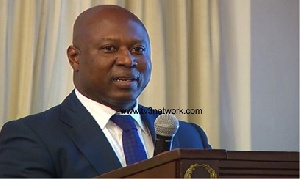 Dr. Abdul-Nashiru Issahaku - Governor of the Bank of Ghana
Dr. Abdul-Nashiru Issahaku - Governor of the Bank of Ghana
Banks operating in the country have reduced their investments in Treasury Bills from 79.2 percent in December 2015 to 78.1 percent December 2016.
According to the Bank of Ghana Financial Stability Report, Banks’ investments in shares and other equities as a share of total investments similarly declined from 2.9 percent in December 2015 to 1.9 percent by December 2016.
Interestingly, the share of securities in total investment, however, increased from 17.9 percent in December 2015 to 20.0 percent during the review period. Investments to deposit ratio also increased to 34.8 percent in December 2016 from 42.5 percent in December 2015.
Treasury bill rates have declined to as low as 16 percent. Presently, the 91-day and 182-day T bill rates are going for 16.50 and 15.74 percent respectively.
The 1-year note is however going for 19.00 percent indicating that government is rather borrowing on the long term rather than short term.
Meanwhile, the main source of asset funding for the banking sector during the review period was total deposits, accounting for 63.6 percent of total assets. Total deposits amounted to GH¢51.66 billion as at end-December 2016, indicating an annual growth rate of 25.2 percent compared with a growth rate of 27.2 percent a year ago.
On the other hand, growth in banks’ borrowings picked up significantly from 15.7 percent at the end of December 2015 to 43.4 percent year-on-year as at end-December 2016. The increase was driven mainly by increases in domestic borrowing, both short-term and long-term.
The banking sector recorded a year-on-year growth of 16.6 percent in minimum paid-up capital to GH¢3.73 billion in December 2016 compared with a year-on-year growth of 20.7 percent in December 2015. The growth in the paid-up capital resulted from the injection of additional capital by some already existing banks to shore up their capital levels, as well as the introduction of fresh capital by newly licensed banks.
Annual growth in shareholders’ funds however declined from 25.0 percent in December 2015 to 16.2 percent in December 2016, due in part to a slowdown in reserve build-up